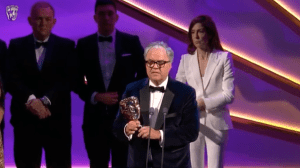The International Olympic Committee (IOC) created its 2021 framework on sex and “gender” around the ideas of fairness, inclusion, and non-discrimination. This framework leaves it to each sport’s governing body “to decide how an athlete may have an unfair advantage over their peers.” However, they warn sports organizations against “targeted testing … aimed at determining [athletes’] sex, gender identity and/or sex variations.” Instead, it’s up to each sport to “[provide] confidence that no athlete within a category has an unfair and disproportionate competitive advantage.”
The IOC’s cleverly crafted argument to reject sex-based categories in sport led 26 researchers from around the world to challenge the IOC’s framework. Their paper, published last week in the Scandinavian Journal of Medicine & Science in Sports, is the latest peer-reviewed study providing evidence of the clear differences between sexes in sports.
The researchers examined studies from “evolutionary and developmental biology, zoology, physiology, endocrinology, medicine, sport and exercise science, [and] athletic performance results within male and female sport” to challenge the IOC’s stance that male athletes do not inherently have an advantage over female athletes based on “biological or physiological characteristics.”
That statement “is ridiculous on its face,” says Kim Jones, co-founder of the Independent Council on Women’s Sports (ICONS). “This is the basic knowledge we all understand and see play out in front of our eyes every day. [This new] paper is brilliant at laying out how clear the differences are between men and women. There are thousands of differences between male and female development in humans across the entire maturity path that result in these huge performance gaps.”
John Armstrong, a mathematician at King’s College London who was not affiliated with this research, highlights this “central flaw” of the IOC’s framework. “To say we should not presume male advantage in a sport unless we have specific data for that sport is like saying that just because most of the apples in a tree have fallen to the ground, one shouldn’t presume the remaining apples are also subject to gravity,” he said.
“There is overwhelming evidence of male advantage from across different sports and there is little to be gained from demonstrating this again and again, sport by sport,” Armstrong noted.
The Myth of Testosterone Suppression
But even sports that have extensive research into sex differences in performance have allowed males to compete in the female category at all levels of competition and age. One route has been through misguided policies based on testosterone levels.
Over the last decade, various sports governing bodies — including the IOC and USA Boxing — have tried to define females through testosterone levels. Those organizations relied heavily on a publication by Joanna Harper, a trans-identifying male medical physicist. The paper consisted of eight self-reports by trans-identifying male recreational runners someone who had reduced their testosterone with medication and remembered that they ran slower because of it. Harper left out the person who said they ran faster and then decided that males who were suppressing their testosterone could compete fairly in the female category.
Last week’s paper adds to previous research by lead authors Tommy Lundberg, Emma Hilton, and others who show that male advantage persists even after testosterone suppression.
While lowering testosterone reduces various measurements of body structure, body function, and physical ability, those changes are only a small part of the differences between men and women in these areas. A male with reduced testosterone will have less muscle mass than before, but as a group, males with reduced testosterone are still bigger and stronger than women. Also, lowering testosterone does not alter characteristics like height, bone length, or hip and shoulder width.
Even before reaching puberty, males perform better than females in sports competitions. Greg Brown, an exercise physiologist at the University of Nebraska at Kearney and co-author of the Lundberg paper, recently conducted research based on national youth track and field championships. He discovered that by the age of 8, the boys ran faster in their final races than the girls did in theirs, across distances from 100 meters to 1,500 meters. boys ran faster than the girls did, in events ranging from 100 meters to 1,500 meters.
When ‘Obvious’ Sex Differences Are Not Enough
Brown’s article was released a few months after John Armstrong (mentioned above), sociologist Alice Sullivan of University College London, and I published a paper on the role of sex versus gender expression in distance running. Despite receiving numerous tweets and articles stating, “Duh, obvious, did we need research to prove this?” I asked Brown if we really needed quantitative research to prove that boys run faster than girls.
“Some court cases concerning transgender athletes competing in girls’ sports indicated there’s no evidence of prepubescent sex-based differences. This kind of work is important to inform policy. Additionally, it can be valuable to assess the obvious because some of the things we assume to be true, maybe they’re not,” Brown said.
The obvious question in response to this accumulation of “obvious” data is: What will it take to restore and enforce sex-based categories in sports at all levels? Even if the International Olympic Committee aligned its policies with the Lundberg paper, the IOC is not binding on youth sports, grassroots sports, or even the NCAA.
Brown is hopeful about “the grassroots level, where girls and women’s sports will start being limited to female athletes. Some school districts and other local organizations are implementing female-only sports policies when state or higher-level organizations won’t.”
Brown mentioned the lawsuit against the NCAA by female athletes will “make those in charge of sports have second thoughts about their transgender inclusion policies. Before there was a fear of lawsuits from transgender activists, but now the situation is different.”
He also called on “scholarly journals, sports science organizations, and sports scientists to speak out and keep the reality of sex-based differences in sports performance in the news to counteract the 20-year head start the transgender activists have.”
ICONS is financing the legal case that Brown talked about. “We need people to understand that there should be no fear or shame in supporting women. It’s a simple message that we all have the duty to communicate clearly,” stated ICONS co-founder Kim Jones. “The stories of women and girls being deprived of fair competition, or even facing injury, are the catalyst for change. It shouldn’t require women and girls being harmed, but everyone has the clear evidence.”
Jon Pike, a sports philosopher and a co-author of the Lundberg paper, recommends sports organizations to rely on the evidence instead of the IOC.
“They are training and nurturing athletes who aim to compete internationally. They owe female athletes the same fair opportunity that they will receive at the international level. Female athletes at all levels deserve fair competition,” he said.
Factual empirical data that align with everyday experience and observation are the most effective responses to the emotion, rhetoric, and threats that often come with attempts to invalidate female-only spaces and categories.
The importance of studies like those conducted by Lundberg, Brown, Armstrong, and their colleagues will be evident in board rooms and courtrooms, not to mention the living rooms where many grassroots sports decisions are made. The more decision-makers can depend on research rather than earnest but shallow complaints of “But it’s obvious!” the more women and girls will thrive in fair and competitive sports.



